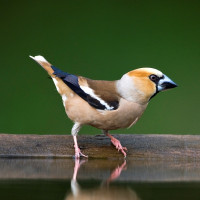Description
The Raspaillebos is about 180 hectares big. It consists of decidious woodland with small patches of coniferous woodland. It is old woodland, in the sense that it has not been converted into other land use in past centuries, but the wood was almost completely cut during the Second World War. Regrowth has started afterwards, but it means that the present state of the woodland is not old growth.
Parts of the wood, especially the more flatlying parts, are coppice wood, which have been cut on a regular basis in the past. Some small parts are still privately owned, but otherwise the wood is largely co-owned by the Agency of Nature and Forests of the Flemish Region and Natuurpunt, the main nature conservation ngo in Flanders. The wood is designated as part of a Natura 2000 site (albeit based on the Habitats Directive and not the Birds Directive). The management of the wood is focused on nature conservation by both the two largest owners.
The Raspaillebos has the typical avifauna of woodland in the 'Vlaamse Ardennen' ('Flemish Ardennes'), a series of low lying hills running westwards from roughly southwest of Brussels. The tops of these hills, and especially the steeper north facing hillslopes have remained forested since long. It is not a superb birding spot and being a woodland it is not a place where birds can be found very easily, but with some effort there is definitely some good birding to be done here! Around the woodland are also some areas with decent habitat where some other interesting species occur.
In the first place the Raspaillebos and its immediate surroundings are a good place for raptors, with six species breeding in the area: глувчар, осојад, јастреб кокошкар, јастреб врапчар, Обична (Црнонокна) ветрушкаl and сокол ластовичар. Four owl species are present, including Кукавија, кукумјавкаl, ушест був and a dense population of Шумски (Обичен) був.
The area has interesting breeding birds such as шумска шљука, four species of woodpecker including среден клукајдрвец and мал клукајдрвец, кукавица, славејче, сиво муварче, црвеноглаво кралче, полски трскар, Обичен (Шумски) лазач, цуцулеста сипка, мала црноглава сипка, дебелоклун црешар and жолтогрла стрнарка. In the past ten years there has been a less then annual but nevertheless regular occurence of Краткокрил вољич on the northern edge of the area, with several long staying singers and several succesful breeding attempts, making this one of the few areas in Flanders where this species is more or less regular, at the northern limit of its European range.
In winter it can be good for raptors, woodpeckers, шумска шљука, дебелоклун црешар, зимовка, flocks of songbirds including varying numbers of северна ѕвингалка and елова зелентарка and a regular wintering occurence of a flock of шумска чучулига.
Details
Access
The wood is cut in half by the Kapellestraat, a cobblestone uphill street which is well known as one of the hills in the Flemish cycling classics.
The wood north of the Kapellestraat is accessible by a network of walking paths. Best access from:
1) the small parking lot at the base of the cobblestone stretch of road, from where a path leads north into the wood, linking to a network of walking trails;
2) the parking lot at the top of the hill on the other side of the cobblestone stretch of road, from where path goes into the wood just left of the campground, linking to a network of walking trails;
3). De Helix information centre (address: Hoogvorst 2, 9506 Grimminge), from where a path leads south to the wood through farmland, once in the wood linking to a network of walking trails.
Information boards with a detailed map of the area and its trails are present at all access points.
The wood south of the Kapellestraat is not accessible itself, but the small dirt road (Noremansberg) going south immediately on your right hand side when you reach the top of the hill up the cobblestone street is worth taking. A few hundred meters down that road there is a good viewpoint overlooking woodland and the small wood (called 'Kluysbos') to the south of that smaller road is accessible by a small walking path.


